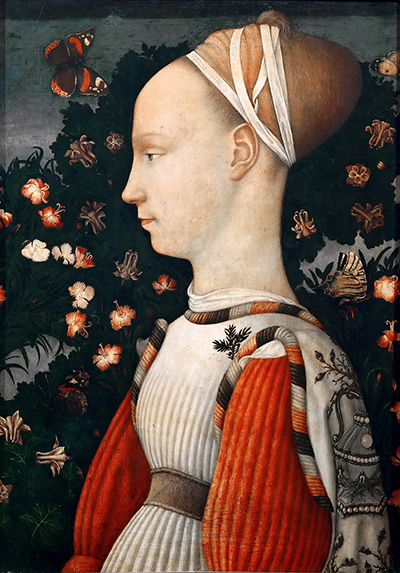Pisanello was a key name in the early Italian Renaissance and Quattrocento and produced artworks in many different Italian towns and cities, including Verona, Ferraras and Milan.
This artist's oeuvre was diverse both in medium and also content. He was truly unique and also innovative, being widely acclaimed as the first to produce portrait coinage, for example. He produced paintings both large and small, from huge murals to smaller, personal portraits. He also took on a number of other genres, with his depictions of birds and animals being particularly unusual and memorable. He was comfortable using both egg tempera with his murals but also watercolours which provided a more subtle finish to some of his drawings, where the additional colours would just lift his pieces. Indeed, many consider his drawings to be the prized asset from his entire career, and they have generally been better preserved up to the present day than his paintings.
As you may have worked out from his name, Pisanello was Pisa-born but would actually spend his life and career in all manner of parts of the fractured nation of Italy. He is believed to have grown up in Verona, much further north of his birthplace, and the earliest work from his long career is considered to be in line with the style of that region. Therefore, one can assume that he received his early artistic training there too, but there is a lack of documentation to confirm this, or to suggest who it might have been that tutored him. There were a number of talented artists in Verona at that time who likely would have encouraged him to join one of their studios as an apprentice, later becoming a full assistant, but again we cannot be sure about this. Despite being a highly respected artist from this early part of the Renaissance, there has not been enough focus on his career in order to answer some of the questions that still remain. This earlier period is also less documented generally than later periods in the Renaissance.
Whilst the first, approximately, twenty years of the artist's life are unclear, we do know for sure that he would then work under the wing of renowned artist, Gentile da Fabriano, from 1415 to 1420. His master is remembered for using an incredible amount of detail within his paintings as well as using a relatively delicate touch and these two characteristics were indisputably apparent in Pisanello's career as well. Gentile da Fabriano worked mainly on religious themes but went beyond just the power of iconography found within religion by also incorporating a momentous level of detail, as seen in Coronation of the Virgin and Adoration of the Magi. He is also generally regarded as being amongst the International Gothic movement, as we now know it, which underlines the traditional artistic styles with which Pisanello was introduced in his developmental years.
Gentile da Fabriano clearly saw great potential in his new assistant and quickly promoted him to become a major contributor in some of his own projects. Doge's Palace at Venice was the highest profile project in which they collaborated but unfortunately those frescoes have not survived to the present day, as with most of their other work together. After his work with this master had ended, Pisanello set out on his own, working for the powerful Gonzaga family in Mantua from 1422 to around the early 1440s. The lack of surviving work from his career has made it especially difficult to fill these periods of his life with any extra detail with regards specific artworks. There are also plenty of other suggestions around these earlier years of his life, with Giorgio Vasari claiming that he worked for Andrea del Castagno, which perhaps would have been in Florence.




